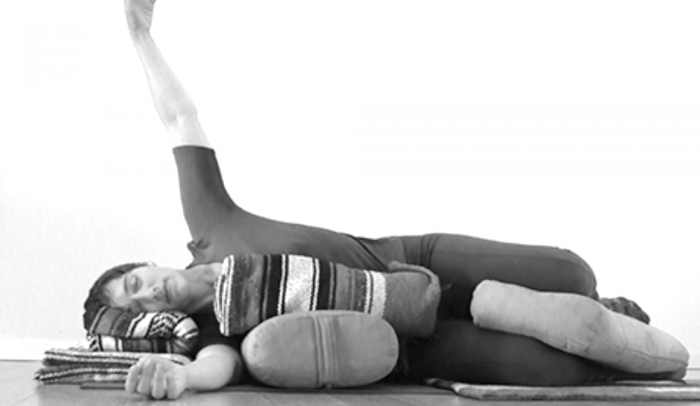Yesterday, I caught myself asking my somatic-inspired yoga class to move “our” heads, and I thought, this is ridiculous.
It’s like when the waiter asks, “What are we having?” and I always have to quiet my inner teenager to keep from saying, “We aren’t having anything, or are you joining us?” None of us are perfect.
Yet, perfection isn’t the mark of a good teacher. No one became a yoga teacher because they were done growing. Instead, yoga teachers are usually driven by curiosity and a desire to do good, to hold space for other people, and to discover their own intrinsic goodness. And often there is a story of injury and of healing that leads to yoga.
I was in a yoga class recently, and the teacher—who is a kind, sincere teacher—said some things that made it challenging for me to take care of myself without quieting both my pleaser and my inner teenager. Learning to quiet these two parts of myself and to choose a wiser response is a wonderful practice. However, for early students of yoga, that might not be the practice you wish your students to be engaging in.
Language choices are opportunities to move around your students’ defiant inner 13-year-olds, and also help avoid the “good student” persona that many of your students carry.
The language you use when leading class can help students become their own teachers, which is the true and sacred task of a teacher.
Language Mishap #1
“Can you just…”
…feel, do, listen—whatever follows these three words is bound to either start a small internal fight or to limit a student’s exploration.
Questions like “Can you…?” immediately suggest that if you can’t do something you are wrong, not doing a good job. Perhaps worse, the words “Can you…?” elicit yes or no answers in the minds of your students. If someone is in a bad mood, for example, the answer may always be no. Even if the answer is yes, that is now the end of the internal conversation.
Yes, I can. So?
For example: “Can you just be in this moment?” Perhaps your student answers internally some mix of the following: “I don’t know. Wait, can I? You know, actually, I can’t. And in fact, now that you have brought it up, here’s a whole list of reasons why not.”
Or, try this: “Can you just roll your shoulders down your back?” A seasoned yoga student knows what to do, and their answer is yes. They do it. They may feel they are doing a good job. A literal student is trying to imagine what that even means. Another student, new to yoga, might have to answer “no” simply because they don’t know what you are talking about. They might feel in some small way that they have failed.
Instead, try questions beginning with how or where, or simply state the direction without the “can you” and the “just.” Questions that begin this way invite myriad ways for the student to answer and to engage with themselves. There are no yes or no answers, and no wrong answers.
Example:
“Lift your arms out wide and high. How do you experience your breath here? Where do you experience effort? Ease?”
Language Mishap #2
“If this is too much/hard, try this:”
The teacher says, “If Eagle Arms is too much today, put your hands on your shoulders.” She offers the language of “today,” which is kind, because, certainly, today eagle arms might not be a good fit. But is it too much? The words too much imply too hard, too challenging, too advanced. So therefore, if your student doesn’t do it, the implication is that they are not as strong, capable, or as good as those who take Eagle Arms.
Here’s another example: “If Chaturanga is too much today, or if you are tired, take Child’s pose.” What if your student’s inner wisdom tells them to do something else? What if they don’t know how to do Chaturanga or have a wrist or shoulder injury? If they take Child’s pose, they are admitting they are tired or weak. Their internal dialogue might be that of their inner teenager: “It isn’t appropriate for me, but now that you’ve challenged me, I’m not going to admit that it’s ‘too much’ because that would be admitting weakness, so I’ll just do the Chaturanga.” Injuries have happened from language like this.
Instead, try offering options simply and clearly. Simple alternatives given as equal choices provide the most space for students to examine their own reasons, needs, and motivations. There are many reasons a student might take an alternative pose.
Examples:
“Take Eagle Arms, or Hugging Arms.”
“Come to Down Dog or Child’s pose, taking a Vinyasa if you wish.”
Of course, for some poses, it is important to specify what situation might be a sign you need a different pose.
Example:
“In Pigeon pose, if you experience knee pain, or simply if you prefer, take Figure-Four.”
Language mistake #3
“Move that foot.”
Sometimes teachers seem shy about talking about our bodies as our bodies. Maybe they feel they are being too bossy, or too personal. Yet, yoga is a unitive practice, a practice that invites us to experience time with and in ourselves in a way that isn’t separate bodies, separate minds.
Instead of words that distance your students from their parts, try simply using the word “your.” As in, “Step your foot to the right.”
Your students are learning how to be with themselves, as body-mind-soul beings. The way you speak can help them befriend themselves, help them listen to, and access, their inner wisdom. Your word choices make the room safe for those who have experienced trauma and injury, and encourage and inspire all students to know themselves.












Read 1 comment and reply